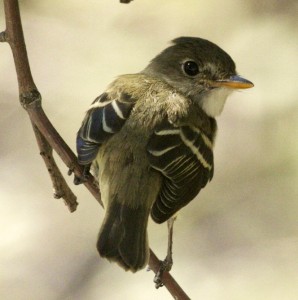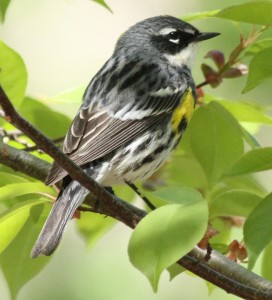Fall Birding Along the Flyway
Posted in Wildlife on September 8 2014, by Debbie Becker
Debbie Becker has been The New York Botanical Garden’s resident bird expert for over 25 years, and continues to lead her popular Bird Walks on Saturday mornings throughout much of the year.

The New York Botanical Garden (NYBG) is the best place to bird during the fall migration. With its diverse habitats it offers birders unique and spectacular views of migrating birds.
The great fall migration begins with the movement of shore birds in late July. The shores of the Bronx River and Twin Lakes often become a good stopover point for spotted and solitary sandpipers. They bob along the shoreline grabbing small insects and crustaceans. In the wetlands, Wilson’s Snipes stop to search for food and temporary shelter.
Warblers, ruby-throated hummingbirds, tanagers, and grosbeaks begin to arrive in late August and remain through early October.
The warblers are headed south with their immature offspring and many are no longer in breeding colors. Some are brown or olive green with one or two wing bars. This gives credence to the phrase “confusing fall warblers.” It is often a challenge to identify some warblers which adds a bit of mystery to birding.
The ruby-throated hummingbirds zip through the garden on their way to Mexico and Central America where they will spend the winter. Their journey of 600 miles is often covered in a single flight! They gather precious nectar from the garden’s flowers; jewel weed and cardinal spikes are their favorites. The nectar provides them with the energy for the long flight.
Tanagers and grosbeaks also arrive to feast on the garden’s dogwood and cherry tree berries. Their dull but brilliant feathers are still a sight to behold. The male scarlet tanager molts from bright red to a greenish yellow in the fall. Immature grosbeaks are usually a combination of brown, black, and red feathers, adding interest to this already spectacular bird.
Without a doubt, the greatest show in September is created by the migrating hawks and eagles. Bald and golden eagles, red-tailed hawks, broad-winged hawks (by the thousands), Peregrine Falcons, Merlins, Sharp-shinned hawks, American Kestrels, Cooper’s hawks, Osprey, and Turkey Vultures are all migrating to their winter grounds.

NYBG is situated in the middle of the greatest stream of migrating birds—in a unique ecosystem of coastal wetlands, forests, meadows, and woodland habitats which make up the Atlantic Flyway. The hawks ride the warm thermals of air along the eastern seaboard, often conserving energy by gliding as they journey to warmer climates.
As if that wasn’t enough, October brings the sparrows; Lark, White Crowned, Fox, Vesper, Savannah, Clay Colored, and more visit our area during October and sometimes linger until mid November. Sparrows are seed eaters and delight in pulling out the thistle or seeds from plants and shrubs. NYBG opened its Native Plant Garden in May 2013, and by the fall of that year the meadow was full of seed-bearing plants just begging to be pollinated by hungry sparrows. This year promises to be even better than last, as the plants have matured since the garden’s opening.
The fall migration at NYBG is a phenomenal event! Join us every Saturday at 11 a.m. to search the skies and forests for fall migrants.


A wonderful article and great photos.
Thanks!